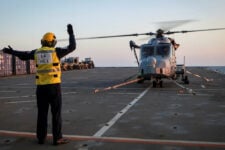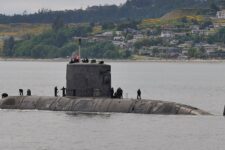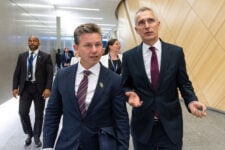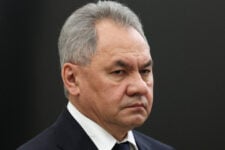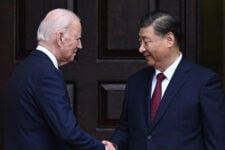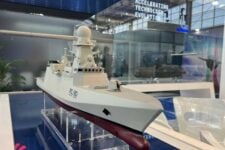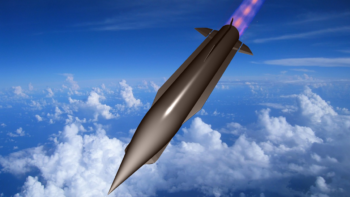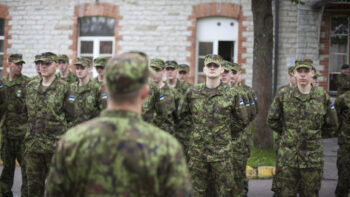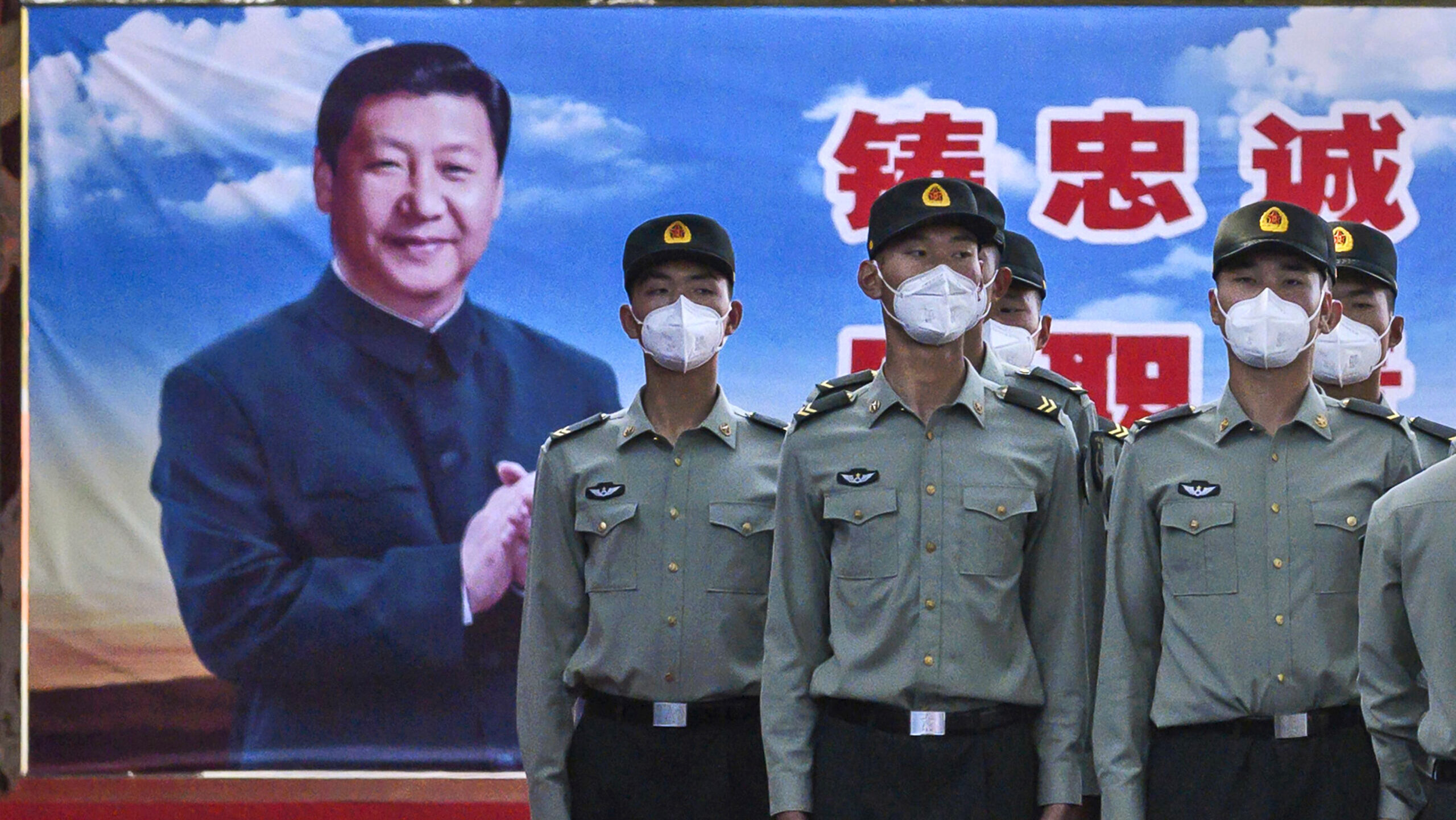
Soldiers of a PLA Honor Guard stand at attention in front of a poster of President Xi Jinping, near Tiananmen Square in Beijing, during the COVID outbreak in 2020. (Photo by Kevin Frayer/Getty Images)
The decision by the Chinese military to transform its Strategic Support Force and launch a new military organization in its wake caught many observers by surprise. In this new analysis, longtime Chinese military expert Dean Cheng lays out what might be behind the change.
On April 19, the Chinese People’s Liberation Army (PLA) held a rare press conference to announce a major change: the disbanding of the PLA Strategic Support Force (SSF), and its replacement with a new entity, the Information Support Force, or ISF. (xinxi zhiyuan budui).
The SSF, which had drawn together China’s electronic warfare, network warfare (including cyber operations), and space warfare forces, had only been established in 2015, as part of the most fundamental overhaul of the PLA since its founding in 1927. It had marked the creation of a service for which there was no counterpart in any other military, a cross-discipline, multi-domain information warfare force.
The 2015 reforms affected almost every part of the PLA. The Central Military Commission (CMC) which manages the overall PLA, was thoroughly reorganized. The peacetime operational command structure of seven military regions was scrapped in favor of five theater commands or “war zones,” which would also be the wartime command structure. And several new services were created, including the SSF, as well as the elevation of China’s nuclear forces from the “super-branch” Second Artillery Corps to the PLA Rocket Force (PLARF). All of these measures were intended to reorient the PLA to an approach of “The CMC governs the overall. The services train and equip forces. The theaters direct operations.”
In many ways, the SSF was emblematic of the larger PLA view of future conflicts. Having not fought a war since 1979, the PLA is forced to rely on observations of other nations’ wars (especially those of the United States) to understand the impact of evolving technologies and international trends. Having concluded that the key to fighting and winning future “informationized local wars” rests upon establishing “information dominance (zhi xinxi quan),” the SSF appeared to be the PLA’s “information warfare force.” By bringing together electronic warfare, network warfare, and space warfare forces under a single umbrella, the goal was to leverage each such force’s capabilities and generate synergies that would help the PLA successfully gather and exploit information more rapidly and accurately than an adversary.
The disbanding of the PLASSF raises questions about what has happened, and where the PLA is going.
What We Know (A Little) And What We Don’t Know (A Lot)
The Chinese Communist Party (CCP) Central Committee and the Central Military Commission (CMC), were said to be the forces behind the SSF’s disbanding. Such attributions typically indicate high-level political decisions, which the elimination of a recently established marquee force would entail in the byzantine world of Chinese politics.
The newly-formed ISF will report directly to the Central Military Commission, suggesting that it is a strategic resource. Chinese President Xi Jinping personally presented the ISF with a military banner during its standup, demonstrating his personal role in its establishment. Xi went on to give some remarks about the importance of this new force for future PLA operations, again signaling the high-level support accorded it.
Heading this force is Lt. Gen. Bi Yi. Intriguingly, he had been the deputy head of the SSF. Also announced was the political commissar for the new ISF, Li Wei. He had previously been political commissar for the SSF. These appointments would suggest that the ISF is simply the next evolution of the SSF, and perhaps politically and bureaucratically comparable.
But where the SSF had control over China’s aerospace and network warfare forces, those are now their own forces. At a rare special news conference announcing the move, PLA spokesperson Wu Qian detailed the establishment of a separate Military Aerospace Force (junshi hangtian budui) and Network Space Force (wangluo kongjian budui), all of which would also report directly to the CMC. These three new support forces would join the Joint Logistic Support Force as “branches” (bingzhong) alongside the four services (junzhong ) of the PLA Ground Forces, PLA Navy, PLA Air Force, and PLA Rocket Force.
What is unclear is the division of labor between the Information Support Force and the Network Space Force. The latter appears to be responsible for cyber and network operations, but how does one separate that from “information support?” The limited Chinese discussions thus far do not indicate which of these new forces would be responsible for electronic warfare, if any, but an essential task on future “informationized” battlefields will be “integrated network and electronic warfare.”
Is that a responsibility of the new ISF?
Moreover, no public announcement was made at the news conference on who would head these two new Support Forces, either, further obscuring their relationship with the new ISF. As new “branches” or “arms,” reporting directly to the CMC, it is also unclear how they would be resourced.
The SSF was, at least nominally, comparable to the services; its commander would therefore be on a rough par with the other services in the struggle for additional financial and human resources. Will each of the new Support Forces now have to struggle on their own for resources? Given the expense associated with space systems (including satellites, space surveillance systems, and counter-space capabilities), this could be very difficult.
Implications
As is typical of the opaque Chinese military system, no real explanation has been forthcoming on why the SSF was disbanded. It, too, had received its banner from Xi upon its founding on December 31, 2015, and it, too, had been described as a key part of helping the PLA prepare for future “informationized local wars.”
Speculation on motive has included the possibility of corruption at the highest levels, with a number of observers noting that the PLASSF commander, Ju Gensheng, not having been seen for some weeks. Others have posited that the PLASSF may have always been a transitory organization, intended to get disparate elements of the PLA (those involved with electronic warfare, space operations, and network and cyber activities) to learn to cooperate. Still others have suggested that the problem may have been a failure to get those same elements to in fact work together.
What does seem clear at this point is that the PLA recognizes that its reforms and modernization efforts are an ongoing effort, which will require further adjustments. In this regard, the PLA seems to be demonstrating that it is a learning organization, willing to take risks and innovate.
At the same time, the imperative for the PLA to be fully modernized by 2027 is now even more challenging. The PLA describes “fully modernized” as being fully mechanized, fully informationized, and fully intelligence-ized. How the establishment of this new ISF relates to the requirements of being fully informationized and fully intelligence-ized is unclear, but under that timeline, there are only 30 months left for this new Support Force to make itself felt.
Dean Cheng is a senior advisor on China at the United States Institute of Peace.

